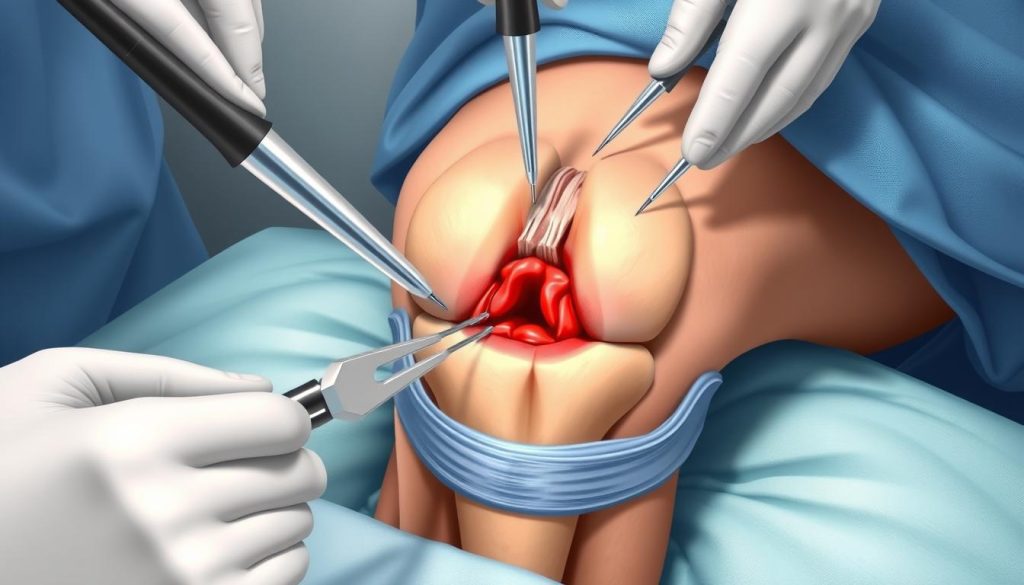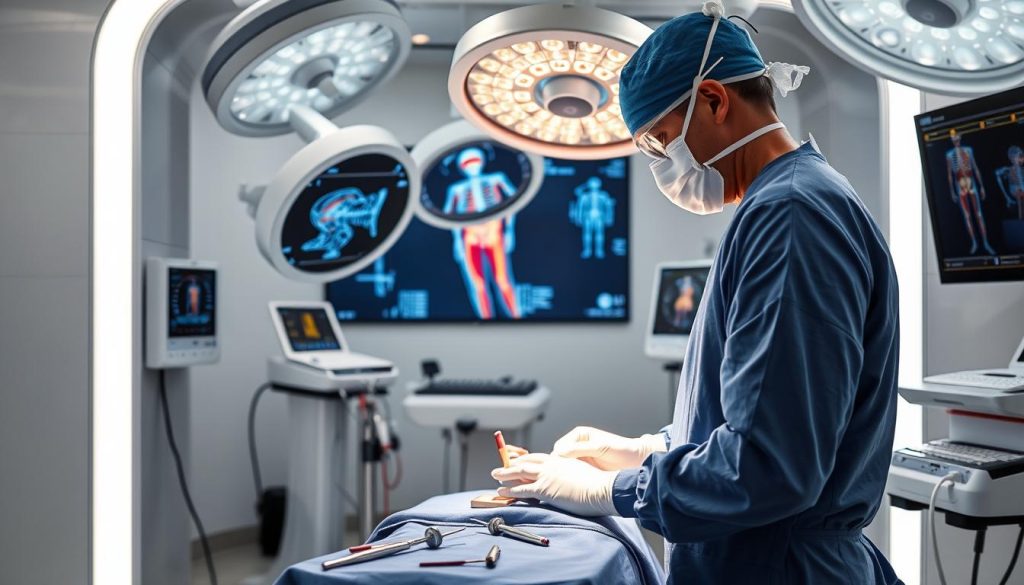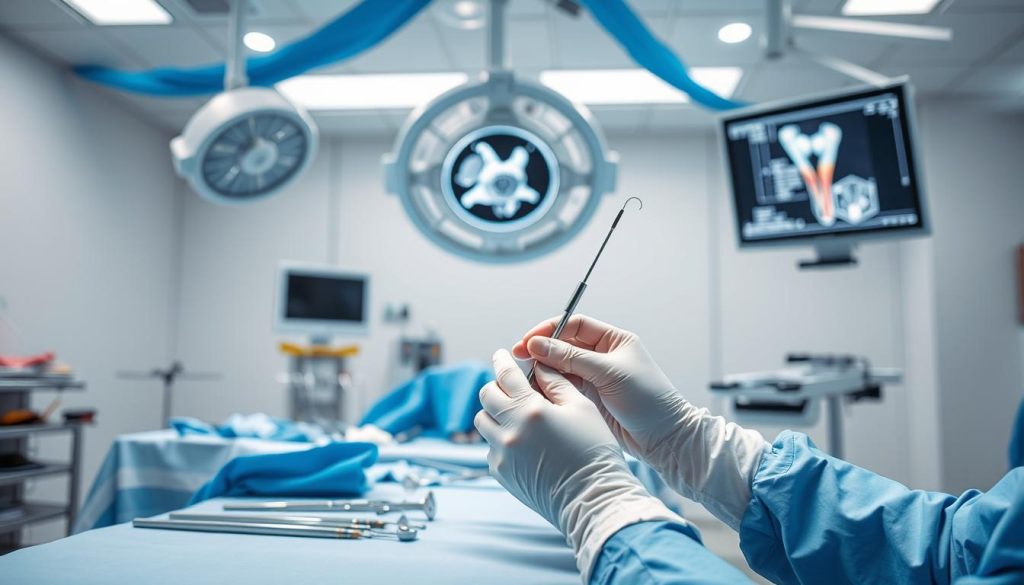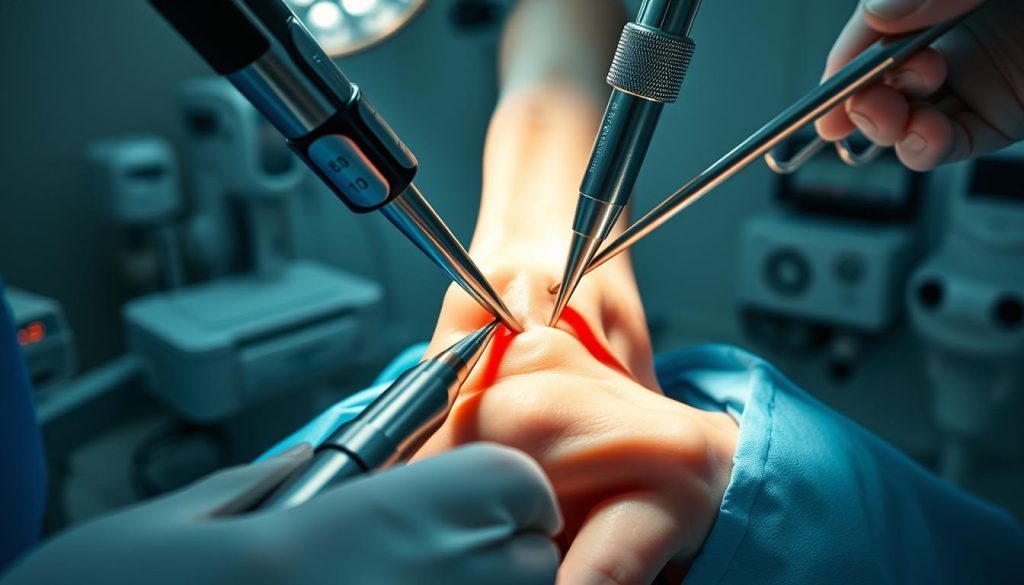Tightrope surgery is revolutionizing joint repair. It’s a new, less invasive way to fix damaged joints. Surgeons make small cuts and use special tools for the repair, avoiding big surgeries.
This method helps patients heal faster and with less pain. It also means less scarring compared to traditional surgeries. Many people can even go home the same day after the procedure.
Doctors use tightrope surgery for many joint problems. It’s great for fixing torn ligaments and unstable joints. This technique is widely used in sports medicine and orthopedics.
As medical science advances, tightrope surgery is at the forefront. It highlights the progress in joint repair. Now, patients have better options to get back on their feet quickly.
Understanding Tightrope Surgery: A Revolutionary Approach
Tightrope surgery is a big step forward in fixing joints. It’s a new way doctors repair joints, giving patients hope for quick recovery and better results.
The Evolution of Joint Repair Techniques
Fixing joints has changed a lot. Old methods were open surgery, which took a long time to heal. Then, arthroscopic repair came along, making cuts smaller and healing faster. Tightrope surgery goes even further, making surgery better.
Core Principles of Tightrope Technology
Tightrope surgery uses a strong, flexible cord to support joints. This cord works like a natural ligament, giving support but letting joints move freely. The success of this method depends on where and how tight the cord is placed.
Benefits Over Traditional Surgery Methods
Tightrope surgery has many benefits over old ways:
- It’s a minimally invasive procedure
- Patients recover faster
- It has fewer risks of problems
- It makes joints more stable
- People can get back to their daily life sooner
| Aspect | Traditional Surgery | Tightrope Surgery |
|---|---|---|
| Incision Size | Large | Small |
| Recovery Time | Several months | Weeks to months |
| Joint Stability | Good | Excellent |
| Risk of Complications | Higher | Lower |
As surgery keeps getting better, tightrope surgery is a top example. It shows how new ways of fixing joints can lead to better results and change the game in joint repair.
Common Joint Conditions Treated with Tightrope Procedures
Tightrope surgery is a great way to treat many joint problems. It’s perfect for knee injuries and ACL repairs. This method is less invasive, helping patients recover faster.

ACL tears are common in sports. Tightrope surgery helps them heal faster and with less scarring. People can get back to their activities sooner.
Ankle sprains, like high ankle sprains, also benefit from tightrope surgery. It makes the joint stable, helping it heal right. This is great for athletes who need to stay active.
Shoulder problems, like acromioclavicular joint separations, can be fixed with tightrope surgery. It holds the joint in place but lets it move naturally. This is key for athletes who do overhead movements.
| Joint Condition | Tightrope Procedure Benefits | Recovery Time |
|---|---|---|
| ACL Tear | Minimal scarring, faster healing | 4-6 months |
| High Ankle Sprain | Improved stability, reduced chronic issues | 6-8 weeks |
| AC Joint Separation | Strong fixation, natural movement | 3-4 months |
Tightrope procedures have many benefits for joint treatments. Patients feel less pain, stay in the hospital less, and recover faster. For those who are active, this makes tightrope surgery a good choice.
The Science Behind Minimally Invasive Joint Repair
Minimally invasive joint repair has changed orthopedic surgery a lot. It uses new science to get great results with less harm to the patient.
Biomechanical Principles
Tightrope surgery uses biomechanics to fix joints. It spreads forces evenly, making the joint stable and move naturally. This way, surgeons can fix joints with smaller cuts.
Tissue Preservation Techniques
One big plus of this surgery is saving tissues. Doctors use special tools to go through small openings. This cuts down damage to nearby tissues, helping patients heal faster and with fewer problems.

Advanced Imaging Integration
Modern joint repair uses new imaging tech. High-def cameras and 3D systems let surgeons see the joint live during surgery. This makes repairs more precise and accurate.
| Feature | Traditional Surgery | Minimally Invasive Technique |
|---|---|---|
| Incision Size | Large (Several inches) | Small (Few millimeters) |
| Tissue Damage | Moderate to High | Minimal |
| Recovery Time | Weeks to Months | Days to Weeks |
| Scarring | Significant | Minimal |
These new ways in joint repair mean patients recover faster and do better. As tech keeps getting better, orthopedic surgery will keep getting more precise and effective.
Preparing for Your Tightrope Surgery
Getting ready for tightrope surgery needs careful planning. This new orthopedic surgery method has many benefits. But, patients must take steps for the best results.

Your orthopedic surgeon will do a detailed check-up before surgery. This includes:
- Physical examination
- Medical history review
- Imaging tests (X-rays, MRI)
- Blood work
Before surgery, you might need to make some lifestyle changes. Your doctor might suggest:
- Quitting smoking
- Adjusting medications
- Following a specific diet
- Starting pre-hab exercises
Finding the right surgeon and facility is key for success. Look for board-certified orthopedic surgeons with experience in new techniques. Ask about their success and patient outcomes.
Mental preparation is as important as physical readiness. Here are some tips:
- Learn about the procedure
- Discuss concerns with your surgeon
- Arrange post-surgery support
- Practice relaxation techniques
By following these steps, you’ll be ready for your tightrope surgery. This will help you have a smooth procedure and a good recovery.
Arthroscopic Techniques in Modern Joint Repair
Arthroscopic repair has changed joint surgery for the better. It offers new ways to fix complex problems without big cuts. This has made recovery times shorter and reduced risks for patients.
Equipment and Technology
Today’s arthroscopic repair uses the latest tools. High-definition cameras and special instruments help surgeons see and work on joints with great detail. These tools let them do arthroscopic AC joint reconstruction and other detailed surgeries through small openings.
Surgical Navigation Systems
Advanced navigation systems have made arthroscopic surgeries more precise. They give surgeons live updates, helping them plan and avoid important areas. Using 3D models and patient data, each surgery is tailored to fit the patient’s needs.
Real-time Imaging Applications
Real-time imaging has changed surgery for the better. Tools like fluoroscopy and intraoperative CT scans let surgeons see the joint as they work. This helps them make quick adjustments, improving the success of the surgery and lowering the chance of problems later.

| Technology | Benefits | Applications |
|---|---|---|
| High-Definition Cameras | Enhanced visualization | Joint surface assessment |
| Navigation Systems | Improved accuracy | Ligament reconstruction |
| Real-time Imaging | Dynamic feedback | Cartilage repair procedures |
These new technologies in arthroscopic repair are changing surgery. They give patients better, less invasive ways to treat joint problems.
Recovery Timeline and Rehabilitation Process
Tightrope surgery helps many patients recover quickly from joint injuries. The rehab process is key for a good outcome, like in knee injury treatment. Here’s what you can expect on your recovery path.
In the first week, you’ll focus on managing pain and doing gentle movements. You might use crutches and start simple exercises to keep your joints flexible. By week two, you can start moving more and might even bear weight.
Weeks 3-6 are when you really start to see progress. Your physical therapy will get more intense, focusing on building strength and stability. You’ll likely be able to do more everyday tasks during this time.
| Recovery Phase | Activities | Goals |
|---|---|---|
| Early (Weeks 1-2) | Gentle exercises, crutch use | Pain control, maintain flexibility |
| Mid (Weeks 3-6) | Increased physical therapy, light activities | Improve strength and stability |
| Late (Weeks 7-12) | Sport-specific exercises, gradual return to normal activities | Full range of motion, normal function |
The final phase, weeks 7-12, is all about intense rehab. Your physical therapist will help you with exercises that match your sport. By the end of this phase, you should be back to your usual activities.
Keep in mind, everyone recovers differently. Your doctor will make a treatment plan just for you. This ensures the best results from your tightrope surgery.
Innovations in Ligament Reconstruction
Ligament reconstruction has made big strides in recent years. Tightrope surgery has changed the game for ACL repair. It brings better stability and strength than old methods.
Tightrope-based ligament reconstruction uses a strong, flexible cord instead of grafts. This method lets for more natural movement and quicker recovery. Patients often feel less pain and swelling after surgery.
Studies show tightrope ACL repair is very effective. A study with 160 patients found 95% could do their pre-injury activities in a year. This beats traditional graft methods.
| Aspect | Tightrope ACL Repair | Traditional Graft Method |
|---|---|---|
| Surgery Time | 30-60 minutes | 1-2 hours |
| Recovery Period | 4-6 months | 6-9 months |
| Return to Sports | 6-8 months | 9-12 months |
These new ways of fixing ligaments are a game-changer for athletes and active people. Tightrope surgery offers faster recovery and better results. It’s now a top choice for ACL repair and other ligament issues.
Sports Medicine Applications and Athletic Recovery
Sports medicine has found a new way to help athletes recover quickly. Tightrope surgery is changing the game for athletes. It lets them get back to their sport faster than ever.
Professional Athletes’ Success Stories
Many top athletes have seen their careers saved by tightrope surgery. NBA star Kevin Durant was back on the court in just six weeks. NFL quarterback Tua Tagovailoa also made a quick comeback.
Return-to-Sport Protocols
Tightrope surgery lets athletes follow custom recovery plans. These plans focus on quick recovery without risking safety. They include:
- Early weight-bearing exercises
- Sport-specific movement drills
- Gradual intensity progression
- Regular strength assessments
Performance Optimization Strategies
Athletes use new strategies to improve their comeback. These include:
| Strategy | Benefit |
|---|---|
| Blood flow restriction training | Accelerates muscle strength gains |
| Neuromuscular re-education | Improves movement patterns |
| Plyometric exercises | Enhances power and explosiveness |
| Virtual reality rehabilitation | Increases engagement and progress tracking |
By using tightrope surgery and these advanced techniques, athletes are breaking new ground. They’re recovering faster and performing better than ever.
Risk Factors and Complications Management
Tightrope surgery is a less invasive way to fix joints. But, like any surgery, it has risks. It’s important for patients to know these risks before choosing this option.
Some common risks include infection, bleeding, and nerve damage. These are rare but serious. Look out for signs like swelling, fever, or numbness.
Tightrope surgery has fewer risks than traditional surgeries. The smaller cuts lower infection chances and speed up healing. But, choosing the right patient is essential for success.
| Complication | Tightrope Surgery | Traditional Surgery |
|---|---|---|
| Infection Rate | 0.5-1% | 2-4% |
| Recovery Time | 4-6 weeks | 8-12 weeks |
| Scarring | Minimal | Moderate |
Surgeons check who can get tightrope surgery. They look at age, health, and joint conditions. Following care instructions helps avoid problems and speeds healing.
If problems happen, act fast. Talk to your doctor about any odd symptoms. Most issues can be fixed, leading to a good recovery and better joint function.
Advanced Surgical Materials and Tools
Tightrope surgery is at the edge of surgical innovation. It uses the latest materials and tools for the best results. Let’s look at what makes this procedure so effective.
High-strength sutures are key in tightrope surgery. These thin but strong threads can handle a lot of tension. They help stabilize joints securely.
Specialized anchors work with these sutures. Together, they make a strong repair system. This system helps joints heal faster and cuts down on recovery time.
Precision instruments are vital in this technique. Surgeons use special tools to work in tight spaces. These tools help place sutures and anchors accurately. This reduces damage to tissue and boosts results.
| Material/Tool | Function | Benefit |
|---|---|---|
| High-strength sutures | Joint stabilization | Durability and tension resistance |
| Specialized anchors | Suture fixation | Secure attachment to bone |
| Precision instruments | Accurate placement | Minimal tissue disruption |
Research keeps improving surgical techniques. Scientists are looking into new materials for better repairs. These new materials could make tightrope surgery even more effective in the future.
Post-operative Care and Physical Therapy
After tightrope surgery, it’s important to follow a good care plan and physical therapy. This helps patients move better, get stronger, and use their joints right again.
Early Movement Protocols
Moving early is key to getting better fast after tightrope surgery. Patients start with simple exercises a few days after surgery. These exercises help loosen up the joint, improve blood flow, and aid in healing.
Strength Training Guidelines
As you get better, building strength is a big part of treating knee injuries. Physical therapists create special workout plans for each patient. These workouts aim to strengthen the muscles around the joint.
- Start with isometric exercises
- Gradually introduce resistance training
- Incorporate balance and proprioception exercises
- Progress to functional movements
Long-term Maintenance Strategies
Keeping your joint healthy after tightrope surgery is a long-term effort. Patients should keep up with exercises at home, stay at a healthy weight, and avoid activities that might hurt the joint. Regular check-ups with doctors help make sure everything is healing right and fix any issues quickly.
“Consistent adherence to post-operative care and physical therapy protocols is vital for long-term success after tightrope surgery.”
By sticking to these guidelines, patients can recover quickly and get back to their normal activities after tightrope surgery for knee injuries.
Comparing Traditional vs. Minimally Invasive Approaches
Orthopedic surgery has made big strides in recent years. The move from old open surgeries to new, small incision methods is a big leap. This change helps cut down on patient pain and gets them back on their feet faster.
Old open surgeries need big cuts, showing the whole joint. New methods use tiny cuts and special tools. This way, less tissue gets hurt and there’s less blood loss.
Recovery time is a big difference. People with the new, small incision surgeries get out of the hospital sooner and can start doing things again faster. The old way takes longer to get back to normal.
| Factor | Traditional Surgery | Minimally Invasive Technique |
|---|---|---|
| Incision Size | Large (6-12 inches) | Small (0.5-1.5 inches) |
| Tissue Damage | Extensive | Minimal |
| Hospital Stay | 3-5 days | 1-2 days |
| Recovery Time | 6-12 weeks | 2-6 weeks |
Even with the many benefits of the new methods, they’re not for every case. Some very complex repairs or serious injuries might need the old way. The choice depends on the patient’s health, the joint’s condition, and the surgeon’s skill.
Patient Selection Criteria and Considerations
Tightrope surgery, including ACL repair, isn’t for everyone. Doctors look at certain criteria to find the best candidates. Age is a big factor. Young, active people usually do better with this surgery.
How active you are also matters. Athletes and those who are always on the move are great for tightrope procedures. They need to get back to their sports quickly, and this surgery helps a lot.
Your overall health is also important. People with strong bones and no health issues are usually better candidates. The type and location of the injury also play a role in deciding if tightrope surgery is right.
- Age: Younger patients often preferred
- Activity Level: High-impact lifestyles benefit more
- Health Status: Good overall health required
- Injury Type: Specific damage patterns suitable for tightrope repair
Before surgery, doctors carefully check each patient. They make sure tightrope surgery is the best choice. This careful planning helps ensure the best results and happiness for the patient. If tightrope surgery isn’t right, other treatments are looked into to meet their needs.
Cost Analysis and Insurance Coverage
Tightrope surgery is a new, less invasive way to fix orthopedic problems. It can save money because patients usually stay in the hospital less and heal faster. The surgery might cost more upfront because of special tools and the surgeon’s skills.
How much insurance covers tightrope surgery depends on your provider. Many see it as a reconstructive surgery, which means they pay a lot of the bill. But, you might have to pay some money yourself, like deductibles and copays. Always talk to your insurance before you schedule the surgery.
| Expense Category | Tightrope Surgery | Traditional Surgery |
|---|---|---|
| Surgeon Fees | $3,500 – $5,000 | $4,000 – $6,000 |
| Hospital Fees | $2,000 – $3,500 | $3,500 – $5,000 |
| Rehabilitation Costs | $1,000 – $2,000 | $2,500 – $4,000 |
To get insurance to cover tightrope surgery, you need to gather all your medical records and get pre-authorization. Some insurers might ask for a second opinion or proof that other treatments didn’t work. Also, going out of network can make things much more expensive, so try to find in-network surgeons.
Even though tightrope surgery might seem pricey at first, think about the long-term benefits. You’ll get back to work faster and need less pain medicine. These advantages make it a good choice for many people.
Future Developments in Joint Repair Technology
The field of joint repair is on the verge of exciting changes. New surgical methods are being developed. These advancements will help both patients and surgeons.
Emerging Technologies
Robotics-assisted surgery is changing arthroscopic repair. It brings better precision and control. Artificial intelligence is also being used to help with planning and making decisions during surgery.
Research Directions
Scientists are looking into new materials that can blend with the body’s tissues. Tissue engineering could help repair damaged joints. These efforts aim to make repairs last longer and improve results for patients.
Potential Breakthroughs
Personalized medicine might be the key to the future of joint repair. 3D-printed implants could be made just for each patient. Nanotechnology could also help by delivering drugs directly to the site of injury. These ideas could make arthroscopic repair more effective and easier for patients.
“The next decade will see remarkable advancements in joint repair technology, promising hope to millions with joint disorders.”
As new surgical techniques emerge, patients can expect faster healing and better results. The future of joint repair looks bright, with new solutions for old problems.
Long-term Outcomes and Success Rates
Tightrope surgery has shown promising results in long-term studies. Research reveals high success rates for this minimally invasive technique across various joint conditions. Patients who undergo tightrope procedures often experience faster recovery times and fewer complications compared to traditional surgeries.
In sports medicine, tightrope surgery has become a game-changer. Athletes treated with this method typically return to play sooner and perform at higher levels. For example, professional football players who had tightrope ankle repairs were back on the field in half the time of those who had standard surgeries.
The success of tightrope surgery depends on several factors. Proper rehabilitation plays a key role in long-term outcomes. Patients who follow their post-op care plans closely tend to have better results. Lifestyle choices, like maintaining a healthy weight and staying active, also boost long-term success rates.
Ongoing research aims to further improve tightrope surgery outcomes. Scientists are exploring new materials and techniques to enhance joint stability and function. As this field grows, patients can expect even better long-term results from these innovative procedures.
FAQ
Q: What is tightrope surgery?
A: Tightrope surgery is a new way to fix joints. It’s good for fixing ligaments. It uses a strong, flexible material to keep joints stable without big cuts or damage.
Q: How does tightrope surgery compare to traditional surgical methods?
A: Tightrope surgery has many benefits. It uses smaller cuts, causes less damage, and you can recover faster. It’s great for knee injuries and ACL repairs.
Q: What conditions can be treated with tightrope surgery?
A: It’s used for many joint problems. This includes ACL tears, ankle sprains, and shoulder issues. It’s very good for knee injuries and fixing ligaments.
Q: How long is the recovery period after tightrope surgery?
A: Recovery times vary. But tightrope surgery lets you start moving quickly. You can start exercises soon and get back to normal activities faster than with old methods.
Q: Is tightrope surgery suitable for athletes?
A: Yes, it’s perfect for athletes. It’s used a lot in sports medicine. Many pro athletes have had it and got back to playing quickly.
Q: What are the risks associated with tightrope surgery?
A: It’s safe, but like any surgery, it has risks. These include infection, bleeding, and repair failure. But, it’s safer than old surgeries because it’s less invasive.
Q: How does tightrope surgery incorporate advanced imaging techniques?
A: It uses new imaging like arthroscopic cameras. These tools help surgeons work more precisely. This makes the surgery better.
Q: What kind of physical therapy is required after tightrope surgery?
A: You’ll start moving early to heal fast. Then, you’ll do strength training and exercises for your sport. The plan depends on your surgery and needs.
Q: How does the cost of tightrope surgery compare to traditional surgical methods?
A: The cost is similar at first. But, tightrope surgery is cheaper overall. It has shorter hospital stays and less rehab time. Check with your insurance.
Q: What future developments are expected in tightrope surgery?
A: New things are coming. Like better materials and using robots in surgery. Research is making it even better and more useful.


















